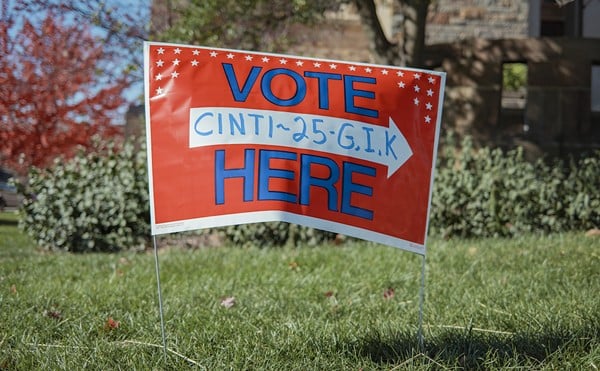When Christians think of Christmas, they think of the birth of the Son. But for some people, this time of year actually marks the birth of the Sun — a spiritual event linked to the longest night and the return of the light.
Called Yule or Saturnalia and other names down the millennia, behind the holiday lies the winter solstice, an event that predates Christ's birth.
Winter solstice is usually Dec. 21, according to Dean Regas, outreach astronomer at the Cincinnati Observatory.
"It's the shortest day of the year for the northern hemisphere," he says. "Typically the sun comes up late, sets early and is lowest in the sky."
In Cincinnati, the shortest day is nine hours and 25 minutes, according to U.S. Naval Observatory data. But not counting seconds and milliseconds, Dec. 18-26 are equally short days.
So astronomers calculate the solstice when the sun reaches 23.5 south of the celestial equator, which happens this year at 7:22 p.m. Dec. 21, Regas says.
Astronomically, solstice ends Dec. 22, and the whole event occurs because of the earth's tilt and orbit around the sun — also the reason for the seasons.
As modern as ever
Ancient cultures, historians relate, weren't so mathematically exact, using observation to reach conclusions. The English word "solstice," from old French and Latin, described what they saw.
Meaning "sun stand still," solstice refers to the approximately three days when the sun appears to rise and set at the same positions in the sky — points that ancient astronomers marked at places such as England's Stonehenge.
Anthropologists say the ancients feared the sun wouldn't return north from its most southerly points; and when they saw it begin to do so, they celebrated.
"Dec. 25 in Roman days was a holiday because they could tell the sun was starting to head north," Regas says.
But winter solstice isn't just an astronomical event or one loaded with superstitions and fear, says the Rev. Lydia Stec of Aquarius Star, a psychic center in Over-the-Rhine.
"It's the darkest night, promising the return of the sun, so whatever wish you want is promised to manifest," she says.
Because of this significance, Aquarius Star opens to the public at 8 p.m. Friday, when Stec and the Rev. Korinne will lead a ritual to focus on solstice's spiritual power to help participants empower their intentions for the coming year.
Primarily secular celebrations even recognize spirituality in the event. On Dec. 21 volunteers at Ohio's Serpent Mound near Peebles will outline the serpent with candles — appropriate because the mound is an ancient calendar that marks the return of the light at the winter solstice sunrise, says organizer Delsey Wilson. This private event for volunteers balances the public commemoration of the summer solstice about June 21.
"The Ohio Historical Society doesn't sponsor any type of religious event, but this is somewhat of a spiritual activity for the volunteers," Wilson says. "For every background, lighting the candles is significant, and they make it meaningful for themselves."
For about 10 years the Cincinnati Nature Center (CNC) has celebrated the solstice with a walk in Rowe Woods, musicians, spiced cider and caroling around the fireplace, all open to the public.
"We are a nature organization which tries to get people in tune with the seasons, and that's why we celebrate the solstice," says Christine Plepys, membership manager at Rowe Woods. "With all the electric lights, people are pulled away from the natural rhythms of the earth."
Though it's not intended as such, Plepys says CNC's event might be a spiritual occasion for some.
"It depends on whatever anybody brings to it," she says. This year's celebration took place Dec. 17.
'Most magical'
The solstice is the Cinderella of the holiday season. Christianity celebrates the birth of Christ on Dec. 25. Our culture's spend-and-party frenzy reflects Rome's Saturnalia. But solstice is largely forgotten, even though it was once the ancient festival of Yule.
Yet if you focus only on Christmas, you might be missing the main event. Ancient wisdom teaches that turning points in the dance of light and dark are significant, because at those times the veil between the physical and nonphysical worlds is thinnest and something special is afoot. This teaching becomes visible in the magic of Christmas lights, which would be nothing without winter's darkness.
In fact, Stec describes winter solstice as "the most magical time of the year," and Native American-trained Diane Samsel, astrologer of Cincinnati's Whole Living Journal, says this is when "Mother Nature is said to send her plan for the new year down to earth." It's also, according to old European teaching, when human, natural and universal cycles are most in tune with each other.
To resonate with that harmony, it's important not only to observe solstice but also to recognize that it marks midwinter — not its start, which our culture mistakenly proclaims, Korinne says. If your notion of the timing of the year's rhythms is out of sync with nature's actual rhythms, your whole life is likely to be out of sync, too, she says.
It would be easy and valuable to incorporate solstice into traditional Christmas spiritual observances. There's nothing to conflict with Christianity, because it teaches God created the sun and the earth and solstice signals their relationship in the universe.
Even though modern culture dismisses as sun-worshippers ancient peoples who observed such events as solstice, this is a travesty of the truth. To them, the sun was not simply a creation of God; it actually God made visible. So observing solstice was simply honoring God.
Solstice has great unifying potential. It doesn't commemorate an event that happened to any specific culture centuries ago. It is an event that happens every year all over the world.
It provides a common ground that anyone, anywhere, can observe and rejoice in, whatever their religion. ©





